We need ice, ice baby!
9. Juli 2021 — General Information, Calf Feeding, Calf Husbandry, Calf management — #Disinfection #Power supply #Heat #Heat stress #Hygiene #CalfGarden #Ventilation #Management #Summer #THI #Dry matter #Veranda #WaterHow do we deal with heat stress in calves?
Literature states that an ambient temperature of 10 – 25 °C (50 – 77 °F) is optimal for newborn calves. This is referred to as the "thermoneutral zone". This is an ambient temperature in which the calf needs no additional energy to compensate for cold or heat. However, this value already drops to 0 °C to 20 °C (32 – 68 °F) at the age of four weeks, meaning that young calves tolerate cooler temperatures quite well.
But at what point do warm temperatures in summer become stressful for calves?
Basically, you cannot take temperature as the only measure, because humidity also plays a major role. We all know this from the weather forecast when they talk about "apparent temperature".
The THI – Temperature Humidity Index – was developed at the University of Missouri in the 1950s. The THI is calculated using the temperature and humidity in the area of the animal. It indicates the temperature and humidity at which growing cows show symptoms of stress. The darker the colour, the greater the stress, right up to the death of cattle above a THI of 99.

You can now find hundreds of these tables on the Internet. The table shown here presents the original data from 1950. However, today's cows are certainly much more susceptible to stress in the heat than they were back then, because they have become bigger and have a more active metabolism due to their enhanced performance. For this reason, it is debatable as to how meaningful this table still is today.
There are, however, studies on the effects of heat stress on calves by L. Kovacs et al. from Hungary. They defined thresholds for stress in calves in 2020 based on the THI. These are the results:

You can see that heat stress starts later in calves than in cows. However, it also causes massive problems in extreme temperatures, just like cows. According to Kovacs, heart rates increase steadily from a THI of 78. Breathing rates increase dramatically from a THI of 82 up to a threefold increase at a THI of 92 (i.e. from 45 breaths per minute to over 120). Body temperatures also rise significantly from a THI of 88.
These are all clear indicators of stress and additional energy consumption, which can start at temperatures as low as 26/27 °C (78/80 °F).
But is that even a problem? According to the table, we should really only worry about 30 °C (86 °F) and above, when the light red area starts. This is different from cows, where the fans already run faster at 20 °C (68 °F).
Even though calves obviously suffer less in warm temperatures than cows, we need to consider some additional factors:
- Calves have fewer energy reserves than cows and are less able to compensate for longer periods of stress.
- Calf immunity is not yet well developed. In this situation, a small or brief stress impulse can be enough to cause symptoms of illness.
- Their lungs do not fully develop until 3 to 4 weeks after birth and even then they have limited capacity. However, since calves react to heat by breathing more heavily, young lungs come under a lot of strain.
This has two major consequences for calves:
- Calves have less energy available for growth.
- This makes them susceptible to disease. This is especially true for respiratory problems.
The responsibility of calf managers
Another important aspect is what I like to call the leaving-the-dog-in-the-car-for-a-very-short-time effect! Every summer we hear stories of people who leave their dog in the car for a very short time to nip in to the baker's. The car heats up within a few minutes and the animal has no chance to escape this situation because it is trapped.
Can this not happen to you? Well, what about your calves in their individual igloos?
Calves have no chance of staying cool when their hutches are in the blazing sun, because it is even hotter outside in the run with direct sunlight than in the warmed up hutch. So the calves stay inside and suffer the heat.
Ultimately, it is not the daily maximum temperatures reported in the weather forecast that are relevant for calves, but the temperatures that prevail in their living area. They are often significantly higher due to heat accumulation.
And to come back to the temperature humidity index (THI): Who has a hygrometer in the barn next to the thermometer to measure the humidity?
The situation in your calf barn is therefore not much different from that of the dog that has just been freed by a couple of courageous pensioners who have smashed a stone through your car’s side window.
12 tips to combat heat stress in calves
So what do we need to bear in mind when the temperatures rise in summer? You can use the 12 tips below as a guide to reducing heat stress in the calf barn:
1. Protect your calves from direct sunlight
It is often recommended to use calf hutches that do not heat up too much. Actually, differences between the different hutches are enormous. Therefore, when buying the hutches, care should be taken to ensure that the material does not let any rays of sunshine through. In addition, the hutches and igloos should have a ventilation system that allows fresh air exchange.
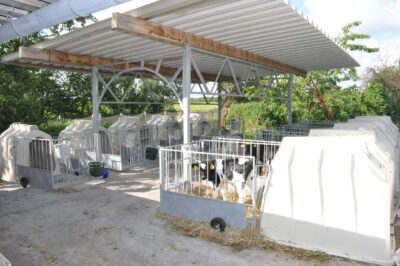
Calf igloos and hutches should always be provided with a covered exercise area, such as the IglooVeranda or the CalfGarden. Calves can then lie down outside in front of the hutch in the fresh air, where a light breeze can cool them down even more. Without a covered area, calves will always lie down in the warm hutch.
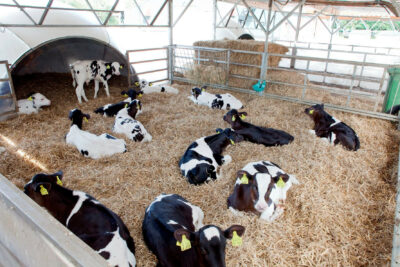
The cover has a second advantage. We always first think of the protection from rain that such a canopy provides. This is also very, very important in summer. Because, if a thunderstorm soaks unprotected bedding in front of the Igloo, humidity will increase after the shower and the stress for calves will remain high, even though the temperature may have dropped from 32 °C to 27 °C (90 to 80 °F). This is because a THI of 32 °C (90 °F) and 50 % humidity and 27 °C (80 °F) and 95 % humidity are the same.
2. Ensure dry bedding
Bedding in the calf barn can be damp even without a rain shower and will cause humidity to rise. The days following a hot spell are often critical. Warm air can retain more water than cold air. So when air cools down, condensation may occur, which also increases humidity in the calf area.
Therefore, dry bedding should always be ensured. Some advisers even recommend a change of bedding material. Sand would of course be a good alternative in the heat (if the run is covered), as is common in the USA, for example. However, handling and disposal could be a problem on most farms.
Longer straw as bedding is beneficial in winter for nest building and insulating calves. But in summer, shredded straw or wood shavings might encourage calves to lie ON the straw rather than IN the straw. This allows calves to release their body heat better.
3. Fan ventilation and spray cooling are not always ideal
What has proven successful with cows is not always necessarily the best option for calves. Of course, well-planned ventilation can reduce the temperature in the barn noticeably, thereby reducing heat stress for the calves. However, care must also be taken to avoid draughts even in summer.
Cooling by spray systems, which is used successfully with cows, should not be used in the calf pen because it can make bedding damp.
4. Provide plenty of fresh water
Calves still have additional water needs even if they drink milk ad libitum. Even at normal temperatures, additional water that is offered has a very positive effect on the development of the rumen flora.
In summer, however, calves need more water to compensate for the moisture lost through sweating. For this reason, always make sure that calves are provided with fresh, cool water on a daily basis. This means that water in the buckets is CHANGED daily (twice a day is better) for individual pens.
The cleanliness of water buckets and drinking troughs in group pens should be regularly checked. Algae formation is not the only problem. The risk of calves becoming infected through drinking water increases because bacteria multiply quickly in lukewarm water. This can be a problem especially with group drinking troughs from which many calves drink.
5. Does offering extra electrolytes help?
Some advisers recommend giving calves electrolytes in their drinking water. However, that is easier said than done. Using the MilkTaxi, you could actually mix water with electrolyte supplements and pour it into the water buckets of the individual pens after the milk feed. I would also recommend this measure when calves are fed restrictively (i.e. a maximum of 8 litres (2 gallon) per day) or when whole milk is used that is not augmented with an enhancer.
However, calves are usually fed more nutrients than they need when they are fed ad libitum. However, care must be taken to ensure that feed intake does not fall in summer. More on this in the tips below:
6. Provide additional energy through a higher milk replacer concentration
When calves have to expend energy to cope with heat stress, as described above, they also have to be given more energy to continue generating sufficiently high gains. However, feed intake decreases on hot days, which does not make things any easier.
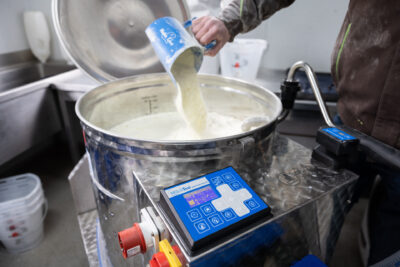
You could increase milk quantities depending on feeding intensity, but it seems to make more sense to increase the concentration of CMR. Calves will then consume sufficient dry matter, even when their milk intake is lower.
7. Ensure hygiene when feeding milk
In summer, ad libitum feeding is particularly challenging, because the milk is in the bucket at warm temperatures all day long. This gives microbes an ideal breeding ground and the milk may turn sour. Controlled acidification to a pH value of 5.5 will help a little in this case. Pasteurising whole milk has proven to be a good method for whole milk feed. If it is subsequently acidified to pH 5.5, it remains stable even when left in a bucket at 25 °C (77 °F) and more for 12 hours.
It goes without saying that cleaning automatic calf feeders, the MilkTaxi, feeding buckets and milk cans is also an important aspect of keeping the original microbial load low. It is important to work very meticulously here, especially in summer. Appropriate aids such as the FlushMaster (cleaning nozzle for feed buckets in the MilkTaxi) or CanWash (holder for cleaning milk cans in the milking parlour) ensure optimal results.
8. Always provide fresh concentrate
Special calf TMR or muesli stand out for their high digestibility. However, pests also find these nutrients very digestible. Feed spoils easily in summer, particularly if it gets wet. It should therefore be provided on a daily basis or dosed through concentrate dispensers so that calves always have fresh feed available.
Calves often reduce concentrate intake before reducing their feeder intake. This is why it seems to make sense to delay the weaning phase a little during the few hot weeks of the year. Otherwise, heat stress is compounded by an energy deficit because feed is withdrawn from the milk faster than the calf can consume additional concentrate.
9. Feed more often, reschedule feeding times
You could consider scheduling feeding times even earlier in the morning or later in the evening when calves do not like feeding in the heat.
This is perfectly possible with good staff planning. The feeding plan below might be a solution:
| Normal feeding routine | Summer feeding routine |
|---|---|
| Morning: 7:00 am (after milking) | Morning. 5:30 am (before milking) |
| Lunchtime snack: 11:30 a.m. (before lunch) approx. half of the normal feed amount (2-3 litres) | |
| Afternoon: 5:00 pm (before milking) | Evening: 6:30 pm (after milking) |
10. Move work with the calves to the morning hours
Just like rescheduling feeding times as described above, it also makes sense to reschedule all other work with the animals to the morning hours. This means that work such as rehousing, mucking out and bedding, health checks or dehorning should take place during the cooler periods.
This is not only more pleasant for the calves, but also for staff. In this respect, it is appropriate to think about a "Southern European working day" where the main work is done before lunch and there is plenty of time for a "siesta" in the afternoon.
11. Combat flies
It is not only the heat that stresses calves, but also a high level of fly infestation. This is because flies love warmth and they love calves' excrement, which contains easily digestible nutrients from the milk feed. Flies are not only a hygienic problem, they also stress the animals by flying directly at them, sitting on them and even biting them. This stress on the calves compounds the stress caused by heat, as the fly population increases particularly over the hot summer days.
Regular mucking out every fortnight AND keeping manure far away from the calf pen can help to reduce the fly population. However, further steps should be urgently taken to control flies if the load is too high.
Milk feeding hygiene is also important with respect to fly infestation. Milk in buckets without a cover, milk spilled on the floor (from dumped buckets) or unsealed CMR bags attract flies as if by magic.
The area surrounding the feeding station of a calf feeder is also ideal for flies. It is humid and there is always some milk residue, even if only a few drops. In addition to the popular teat rinsing, we therefore also recommend cleaning the HygieneStation and the saliva bowl twice a day with a water hose.
12. Harness the sun to disinfect calf hutches
However, heat is not just stressful, it also allows you to disinfect empty calf hutches directly in the sun after thorough cleaning. Also, the ground surface on which the hutches stood is disinfected in the sun after a few days. However, only if, like the hutches, it has been thoroughly cleaned beforehand.
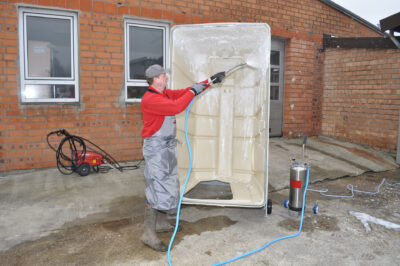
It is important to remove manure immediately and to clean surfaces immediately, because firstly, it is difficult to remove dried manure and secondly, the straw mat continues to provide excellent conditions for microbes and flies to develop.
We are certain that these 12 tips provide useful guidance on how to achieve good results in calf rearing even during the summer months. Discuss each of these topics with your team and assess, as objectively as possible, how well prepared you are for the hot days.
Would you like to learn more? The

 THI for cows according to the University of Missouri 1950
THI for cows according to the University of Missouri 1950
 THI for calves according to L .Kovacs 2020
THI for calves according to L .Kovacs 2020
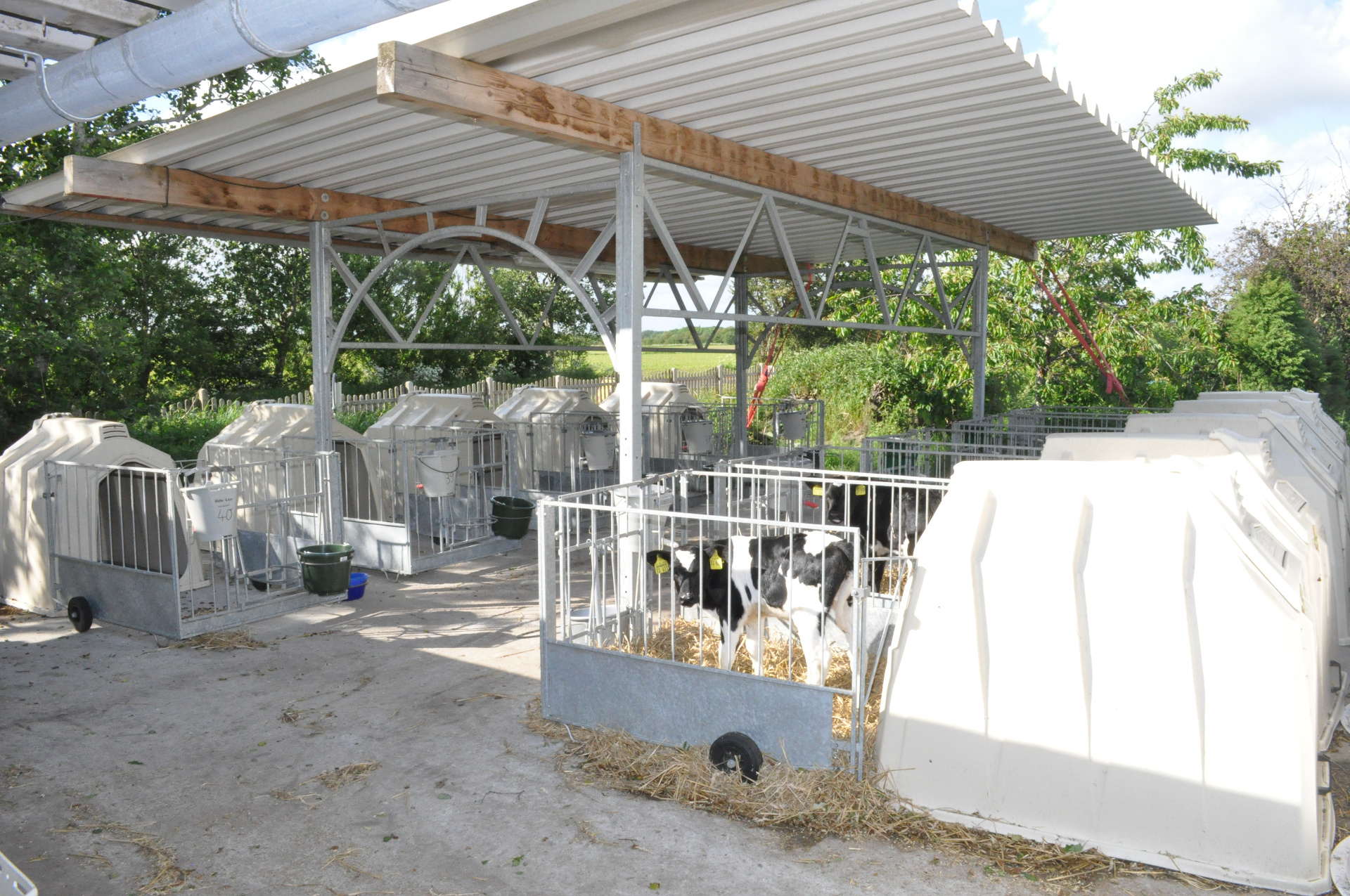 CalfGarden
CalfGarden
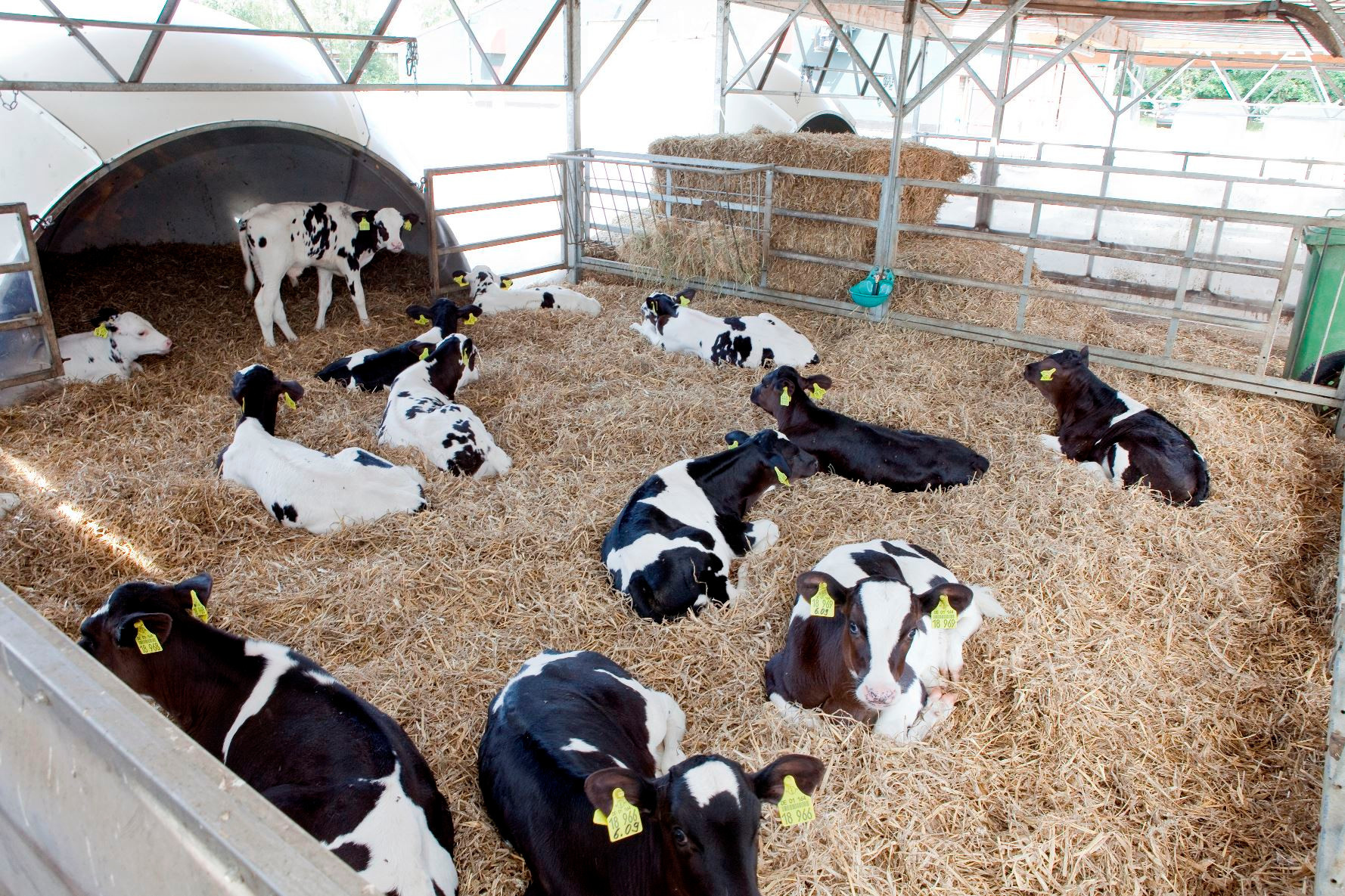 IglooVeranda
IglooVeranda
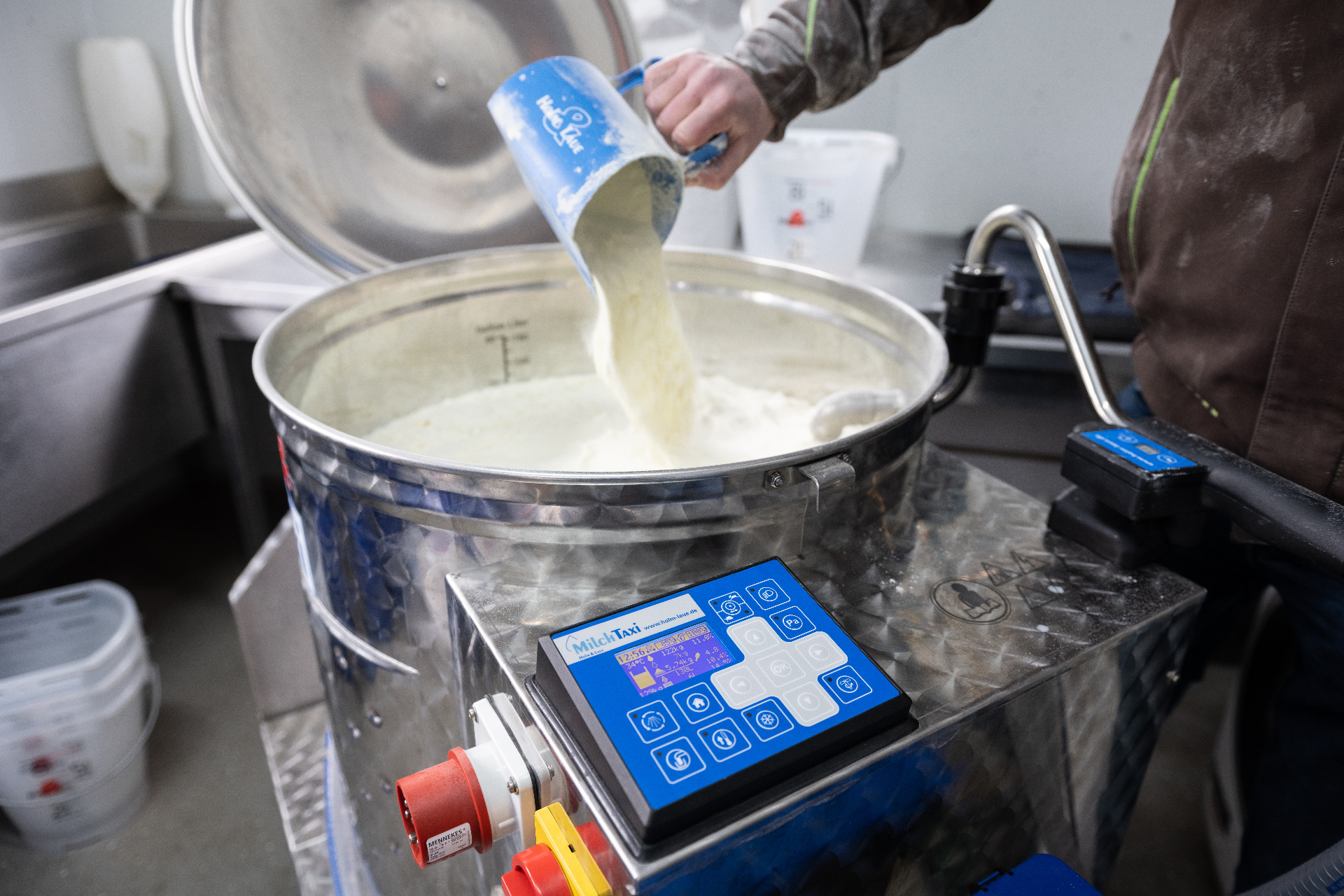 SmartMix at the MilkTaxi
SmartMix at the MilkTaxi